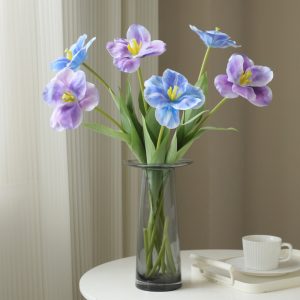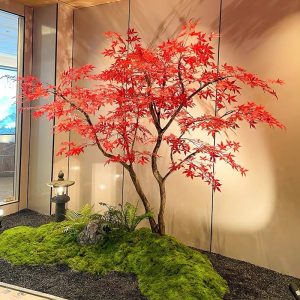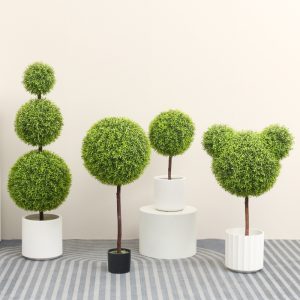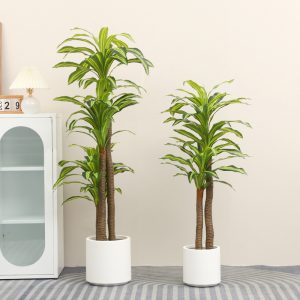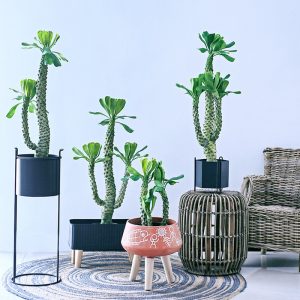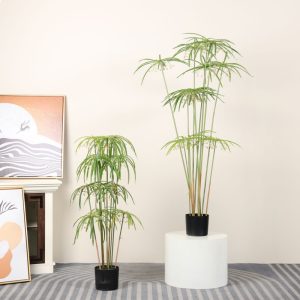With many years of experience in the artificial plant industry, I’ve noticed that many people focus on appearance when buying artificial plants, overlooking the key factor: material. In fact, the material directly determines the lifespan of the artificial plant and the best placement for it. High realism is not just about design, it’s about the materials! Today, I’ll take you through the common types and materials of artificial plants in the market and provide practical advice to help you choose beautiful and durable plants.
1. Choose by Size: Where to Place at Home or in a Store?
Small Desktop Plants (Height < 30cm)
Mainly for delicacy: Ideal for desks, windowsills, or bookshelves.
- Popular Picks:
- Artificial Succulents (e.g., Aloe Vera, Panda Plant, Crassula): Ensure the leaves are sufficiently “meaty” and have a natural waxy sheen. Poor-quality ones may look wilted or stiff.
- Mini Potted Plants (e.g., Mini Monstera, Small Pothos): Focus on detail—leaf vein clarity and natural-looking soil.
- Micro Bonsai (e.g., Artificial Pine): The branches should be firm, with high-quality versions allowing for adjustable shapes.
Living Room/Island Main Plants (30cm < Height < 120cm)
Designed to impress: Best placed in living rooms or central store displays.
- Common Types:
- Leafy Giants (e.g., Monstera, Fiddle Leaf Fig, Areca Palm): Leaves should spread naturally, and the stems must be resilient to avoid breakage.
- Flowering Champions (e.g., Artificial Hydrangea, Lily, Bird of Paradise): Petals should have defined layers, each around 0.2mm thick.
- Shaped Plants (e.g., Lollipop-style Greenery, Eucalyptus Balls): Ensure symmetry with minimal deviation (<5% mismatch).
Space Divider or Background Plants (Height > 120cm)
Perfect for separating spaces or as background decor.
- Common Types:
- Artificial Trees (e.g., Traveler’s Palm, Rubber Plant, Dracaena): Stems should resemble natural bark textures, and the whole plant should be stable to avoid tipping over.
- Bush Groupings (e.g., Large Bird of Paradise Combo, Banana Shrubs): Leaves should be arranged naturally and alternately.
- Vertical Greenery (e.g., Ivy, Climbing Vines): Used for plant walls; leaves should have enough density to cover gaps.
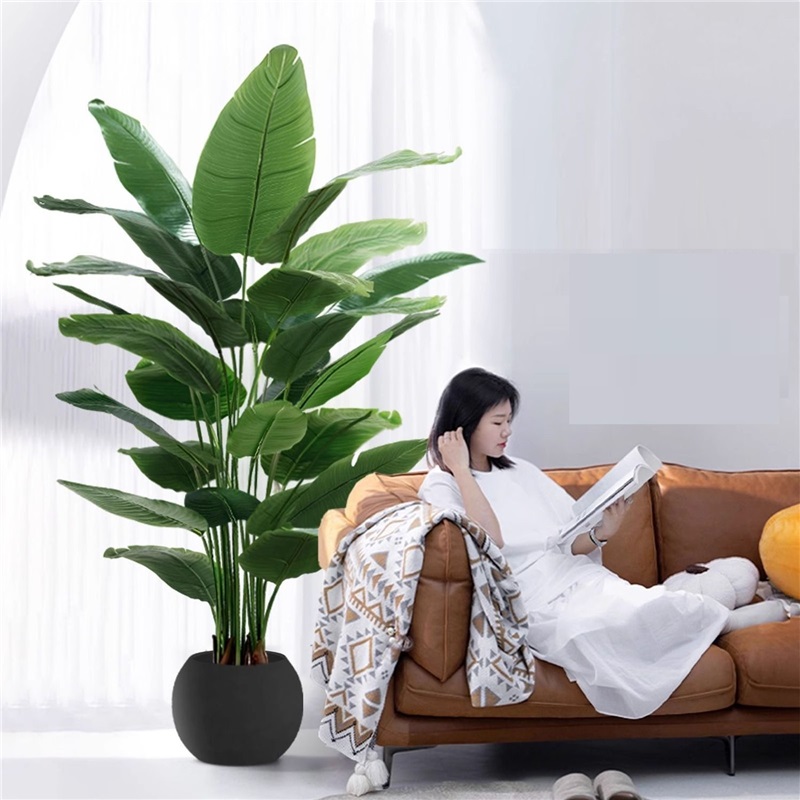
2. Core Materials Revealed: From Budget to Premium, What’s Best for You?
Entry-Level: PVC vs PE – Affordable Options
- PVC (Polyvinyl Chloride):
- Pros: Affordable, durable, maintains color stability (fading less than 10% after six months of sun exposure).
- Cons: Stiff texture, leaves prone to creases, becomes brittle in low temperatures.
- Best for: Budget-friendly decorations, exhibitions, weddings, and corridors or hallways with minimal sunlight.
- PE (Polyethylene):
- Pros: Softer and more flexible than PVC, more durable, better for bending into different shapes.
- Cons: Less vibrant colors, slight yellowing over time.
- Best for: Areas with frequent contact, such as children’s rooms, pet areas, or heavily trafficked spaces.
Intermediate: PU & Silicone – Quality Upgrade
- PU (Polyurethane):
- Pros: Mimics plant “flesh,” lightweight (30% lighter than PVC), delicate detailing.
- Cons: Sensitive to heat, deforms over 40°C, 2-3 times more expensive than PVC.
- Best for: Close-up plants like table centerpieces or dressing tables.
- Silicone:
- Pros: Extremely realistic, smooth, weather-resistant, adapts to both extreme cold and heat.
- Cons: Expensive, heavy.
- Best for: High-end locations like luxury hotels, showrooms.
Special Materials: Fabric & Paper – Stylish Choices
- Fabric:
Often used for flowers like roses and carnations. The density of the fabric creates 3D petals, and high-end fabric flowers may even feature flocking to simulate petal fuzz.- Cons: Not very durable, difficult to clean, water-sensitive.
- Best for: High-up or rarely touched places like top shelves or decorative walls.
- Paper:
Eco-friendly, commonly used in seasonal decorations like Christmas branches or New Year garlands.- Pros: Lightweight, biodegradable.
- Cons: Prone to damage in humid environments.
- Best for: Short-term or dry-area decorations.
3. Practical Pairings: Choose the Right Material for the Right Environment
Humidity:
- Bathrooms, Kitchens (high humidity): Choose silicone or PE; fabric and paper can mold easily.
- Air-conditioned or Heated Rooms: Fabric and PU are ideal; PVC can become brittle in dry conditions.
Lighting:
- Bright Sunny Areas (e.g., balconies, windowsills): Must have UV protection coatings; PVC and PE can be treated with coatings. Without this, they’ll fade quickly.
- Dimly Lit Spaces (e.g., corridors, basements): PU or silicone maintain natural sheen and colors.
Touch-Prone Areas:
- Children’s Rooms, Fitting Rooms: Opt for PE or silicone—fabric and paper are prone to damage.
- Offices, Showrooms (low interaction): PVC or fabric will suffice.
4. Environmental Considerations: Health and Sustainability Matter
- PVC: When purchasing, ensure it’s ROHS-certified (heavy metals <100ppm). Low-quality PVC may release formaldehyde.
- PE/PU: These materials are generally more eco-friendly and food-safe, making them ideal for homes with children.
- Recycled Materials: Many high-quality artificial plants now use recycled plastics (e.g., PET bottles). Look for labels that indicate PCR (Post-Consumer Recycled) content greater than 30%.
5. Pitfalls to Avoid: 3 Common Mistakes When Buying Artificial Plants
- Beware of the “All Silicone” Hype: Some sellers claim their plants are entirely silicone, but the main trunk is still PVC. Check by pressing the trunk; if it bounces back, it’s silicone. If it’s hard, it’s PVC.
- The Pot and Soil Matter: High-quality plants come with “distressed” pots and natural-looking soil, mixed with stones or bark. Avoid those with just plastic pellets.
- Don’t Chase “Too Realistic”: Sometimes, overly realistic leaves, especially for outdoor plants, attract dust. Choose matte-finish PVC for easier maintenance.
Summary:
Most customers find that when they choose the right material, artificial plants become more durable and hassle-free. For instance, in a dry office, a mid-range PE Monstera outperforms an expensive silicone plant in terms of longevity and environmental compatibility.







